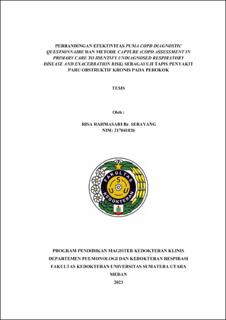| dc.contributor.advisor | Pandia, Pandiaman | |
| dc.contributor.advisor | Pradana, Andika | |
| dc.contributor.author | Sebayang, Risa Rahmasari Br | |
| dc.date.accessioned | 2024-03-27T02:37:37Z | |
| dc.date.available | 2024-03-27T02:37:37Z | |
| dc.date.issued | 2023 | |
| dc.identifier.uri | https://repositori.usu.ac.id/handle/123456789/92798 | |
| dc.description.abstract | Background: COPD is a global disease with a high burden on health, economy,
and society. Smoking is the primary risk factor leading to irreversible lung damage.
Early detection of COPD is crucial in preventing increased morbidity and mortality,
particularly in active smokers. Screening and early treatment are vital in reducing
the progression and impact of chronic obstructive pulmonary disease.
Method: This study is an observational study with a cross-sectional design
conducted on a population of smokers. Data were obtained through interviews using
two COPD screening questionnaires, namely PUMA and CAPTURE, followed by
spirometry examination. Bivariate analysis using the Spearman test was used to
examine the relationship between CAPTURE and PUMA scores based on
spirometry. ROC analysis was used as a sensitivity and specificity test to determine
the cut-off scores for CAPTURE and PUMA in identifying COPD.
Results: This study revealed the characteristics of smokers in the age range of 51-
60 years (38.1%) with a history of smoking initiation between 15-20 years of age
(65.8%). The majority of smokers were male (81.5%) with moderate smoking
intensity being the most common (44.8%). Spirometry results showed that the
majority of smokers had obstruction (65.1%), especially severe obstruction (42.5%).
The optimal cut-off value for the PUMA score was ≥ 6, with a sensitivity of 72.55%
and specificity of 84.00%, while for CAPTURE, it was 4, with a sensitivity of 70.83%
and specificity of 64.29%.
Conclusion: PUMA has relatively high sensitivity and specificity, while
CAPTURE has lower sensitivity and specificity values. Based on this study, the
effectiveness of the PUMA questionnaire is better than the CAPTURE
questionnaire. | en_US |
| dc.language.iso | id | en_US |
| dc.publisher | Universitas Sumatera Utara | en_US |
| dc.subject | COPD | en_US |
| dc.subject | Screening | en_US |
| dc.subject | CAPTURE | en_US |
| dc.subject | PUMA | en_US |
| dc.subject | Smoking | en_US |
| dc.subject | Spirometry | en_US |
| dc.subject | SDGs | en_US |
| dc.title | Perbandingan Efektivitas PUMA COPD Diagnostic Questionnaire dan Metode Capture (COPD Assessment in Primary Care to Identify Undiagnosed Respiratory Disease and Exacerbation Risk) sebagai Uji Tapis Penyakit Paru Obstruktif Kronis pada Perokok | en_US |
| dc.title.alternative | Comparison of The Effectiveness of PUMA COPD Diagnostic Questionnaire and Capture Method (COPD Assessment in Primary Care to Identify Undiagnosed Respiratory Disease and Exacerbation Risk) as A Screening Tool for Chronic Obstructive Pulmonary Disease in Smokers | en_US |
| dc.type | Thesis | en_US |
| dc.identifier.nim | NIM217041026 | |
| dc.identifier.nidn | NIDN0019056110 | |
| dc.identifier.nidn | NIDN0023128907 | |
| dc.identifier.kodeprodi | KODEPRODI11103#Ilmu Kedokteran Klinis | |
| dc.description.pages | 83 Pages | en_US |
| dc.description.type | Tesis Magister | en_US |




